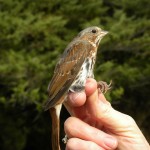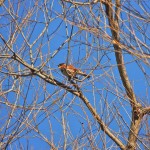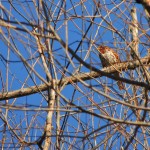11 November 2014. Burlington ON. This just might have been the last warm day of the year. Taking advantage of this beautiful grab-it-while-you-can day, we took our exercise along a bird-rich valley and were well rewarded.
My companion soon spotted a very unexpected Cooper’s Hawk sitting on the railing of a large pedestrians-only bridge. Knowing that Cooper’s Hawks rarely tolerate human closeness for long, and hoping for a perfect photograph, I moved closer as unobtrusively as possible. Well, the results weren’t great but here’s what we saw.

Recently I dwelt on the mild embarrassment of being phalaroped; that is to say, leading myself down the garden path to an incorrect identification. I came close again today. We approached a group of three smallish birds high overhead in a bare, perhaps dead, tree. Through binoculars and craning my neck, I struggled to make an identification. Eventually I concluded that I was looking at three juvenile Rose-breasted Grosbeaks. I thought I was seeing the streaky underside of three young males with a vague patch of crimson at the throat. Their size was right, the timing was okay, but not perfect, Rose-breasted Grosbeaks should be well on their way to Guatemala by now, and frustratingly, I couldn’t think what else they might be. Fox Sparrows was a possibility, although I don’t associate them with tree-tops, they are birds of the forest floor that like to scratch around in leaf litter. My camera is the perfect tool in marginal viewing situations like this, so propping it against a stable surface, I took several pictures for closer scrutiny later. I’m glad I did for that’s when the Rose-breasted Grosbeak idea came unstuck.
Above (in a gallery visible only on the website, not if you’re reading this as an email.) are a couple of reasonable photos of today’s birds as well as another individual in the hand for comparison. I make today’s birds Fox Sparrows. Here’s why: The imagined crimson at the throat turns out more of an agglomeration of brownish-red spots the same colour as its wings and under-tail, and consistent with a common field mark of Fox Sparrows. The reddish chevrons on the breast and belly are right for a Fox Sparrow, and wrong for a grosbeak. I’m left, however, puzzling over these three being way up high and exposed on top of a tree when I always though of them as birds of the low leafy understory. Most reference books make that point, only Pete Dunne acknowledges that Fox Sparrows, when flushed, often fly straight to take a high perch in a tree. Conclusion: there’s always something to be learned and the birds don’t necessarily read the texts.
There were other nice birds this morning. Notably, several shiny Green-winged Teal dabbling and swimming alongside some, giant by comparison, Mallards. Later a Sharp-shinned Hawk wheeled low overhead showing off the bands of its fanned tail and its under-wing patterns.




Catherine & I find that reading TO the birds helps them reveal themselves and follow the ‘rules’ 🙂
Hello. Newbie here. I’ve been enjoying your posts much of the year. I took your advice and purchased Pete Dunne’s book about a month ago online at Chapters/Indigo. The book remains in stock at about $30.00. Thank you oodles for your recommendation.
I photographed a shorebird two or three weeks ago. We couldn’t decide whether it was a greater or lesser yellowlegs. Based on the bird’s behavior (calm demeanor while foraging) per Mr. Dunne’s book, we decided it was a lesser yellowlegs. However, others have listed it as a greater yellowlegs. Aargh.
Carry on the good work. Know that it is not in vain!